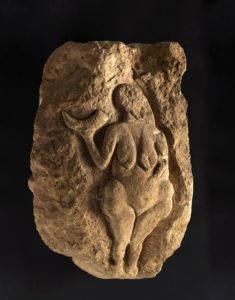Venus of Laussel Goddess

I keep on seeing crescent shapes, moons…so I”m posting this article written by Erin Dragonsong. When I read it resonated with me.
Generally called the Venus of Laussel or Femme à la Corne (Woman of the Horn), this prehistoric Mother Goddess was carved in stone-age France between 20,000 and 30,000 years ago. Her face is a mystery, turned to gaze on the all-important horn in her right hand, her hair falling over her left shoulder. And she was painted with red ochre — another common symbol in prehistoric Goddess icons. Her belly is rounded with pregnancy (the artist taking advantage of the natural form of the rock, it seems), expressing her role as Divine Mother. Unlike many ancient Goddess, the Venus of Laussel is shown with arms: the one holding the horn in full detail; her left hand rests on her belly — a position familiar to all expectant mothers. Her lush thighs and heavy breasts indicate one who has given birth and suckled children many times. As with many Mother Goddess, her role as Creatrix/Generatrix is emphasized in her proportions: enhancing the child-bearing attributes, while the rest is smaller in comparison.
The Horn of the Venus of Laussel
The most unique, and telling, feature of the the Venus of Laussel is the horn She holds aloft. It’s a bovine (cow) horn: a very ancient symbol of the Moon and the Mystery of Menstruation — the source of life… and thus a symbol of the Mother Goddess or Great Goddess. Furthering the correlation of horn and Mother Goddess/Creatrix, this horn is carved with 13 marks, making it a lunar calendar. Her face is forever turned towards this moon/horn, signifying its importance. This lunar-horn symbol is also a cornucopia, symbol of the abundance of the Earth and Goddess. Archeologists still argue about the meaning of this symbol… whether it’s a horn or a cornucopia, in the typical scientific mindset that something must be either/or. But it’s both simultaneously. The horn and the cornucopia hold almost an identical meaning: abundance and fecundity through the Divine Mother. Both are symbols linked with the Mother Goddess throughout history. In a similar vein, archeologists still argue about whether the Venus of Laussel is, in fact, a Goddess figurine at all. They apparently do not have enough facts to determine, definitively, if this is the case or not. Personally, this makes me laugh — archeologists have decided on many other things with even fewer categorical clues… the “kings” of Crete spring to mind. But to decide on a woman of spiritual power and cultural significance is not a leap that comes as easily. We who have eyes to see, know that there is no doubt whatsoever that the Venus of Laussel could only be a Mother Goddess.

Fantastic analysis. Thank you.
Thank you for your comment! Venus of Laussel Goddess is an iconic symbol. This article helped me to reconcile many visions, but the most profound symbol, the crescent shape. I’m happy you found value in the write up.
Hi, I appreciate that you’ve attributed the article correctly. Still, it’s essential to post a link back to the original article. Otherwise this is piracy and theft. Thank you.
Absolutely! Please note I have added the full link. Thank you for your comment and the kindness with which you expressed yourself.
Love and light,
Laurene